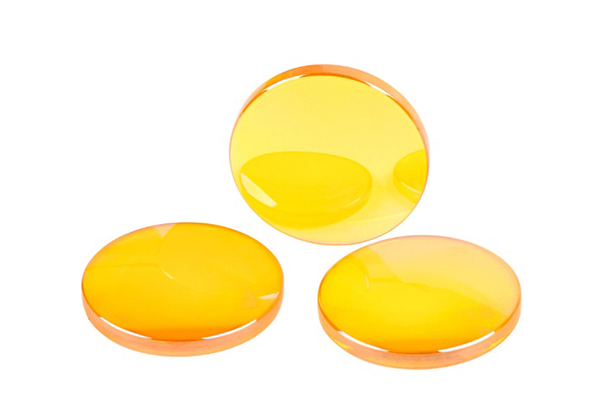Introduction to Zinc Selenide
In the field of optical materials, zinc selenide (ZnSe) stands out for its exceptional performance and wide range of applications. Known for its broad transmission band and low absorption in the red portion of the visible spectrum, ZnSe is a material of choice for optical systems integrating CO2 lasers and infrared applications. This article delves into ZnSe’s unique properties, applications, and why it has become the material of choice for industries employing advanced optical technologies.

Understanding Zinc Selenide: Properties and Characteristics
ZnSe is an inorganic compound with the molecular formula ZnSe. It is a lemon-yellow solid that typically appears dull due to oxidation. As an intrinsic semiconductor, ZnSe has a band gap of approximately 2.70 eV at 25°C, corresponding to a wavelength of 459 nm. Its crystal structure is primarily cubic zinc blende, which contributes to its optical and mechanical properties. Transmission Range: ZnSe is transparent in the 0.6–16 µm wavelength range, making it well-suited for infrared applications.
1. Refractive Index: ZnSe has a refractive index of 2.4028 at 10.6 µm, making it well-suited for CO2 laser optics.
2. Thermal Properties: ZnSe has a thermal conductivity of 18 W m⁻¹ K⁻¹ at 298 K and a melting point of 1525°C, making it resistant to high temperatures, but it undergoes severe oxidation at 300°C.
3. Mechanical Properties: ZnSe is relatively soft, with a Knoop hardness of 120, making it easily scratched and requiring careful handling.
Applications of Zinc Selenide in Optical Systems
- CO2 Lasers: ZnSe is the material of choice for CO2 laser optics operating at a wavelength of 10.6 µm. Its low absorption and high thermal conductivity contribute to the efficient performance and long-term durability of high-power laser systems. ZnSe is partially transparent in the visible spectrum, making it easy to align systems using red helium-neon lasers.
- Infrared Optics: Due to its excellent transmittance and low absorption properties, ZnSe is widely used in infrared optical systems. Applications include thermal imaging, forward-looking infrared (FLIR) systems, and attenuated total reflection (ATR) prisms. In thermal imaging, ZnSe lenses capture and focus infrared radiation, converting it into visible images that are crucial for night vision, security surveillance, and medical diagnostics.
- Spectroscopic ATR Prisms: ZnSe is the material of choice for ATR prisms due to its high refractive index and wide transmission range in the infrared spectrum. ATR spectroscopy is a powerful technique in infrared spectroscopy that allows for rapid sample analysis without specialized preparation.
- Optical Collimation: Unlike germanium and silicon, ZnSe transmits a portion of visible light, making it suitable for visual optical collimation in various optical systems.
MOK Optics: Leading the ZnSe Optics Industry
MOK Optics is a renowned manufacturer of laser-grade ZnSe lenses and windows with antireflection (AR) coatings. These components are crucial for improving the performance of optical systems by reducing reflection losses and increasing transmission. MOK Optics offers a range of ZnSe products, including wedged windows that eliminate fringe patterns and prevent cavity feedback, which is crucial for protecting laser output from environmental influences.
Handling and Safety Considerations
While ZnSe is highly valued for its optical properties, it must be handled with care due to its softness and toxicity. Always wear gloves when handling ZnSe optics and wash your hands thoroughly after handling. ZnSe is a hazardous material, and appropriate precautions should be taken to ensure safety.
Optical Coatings: Enhancing ZnSe Performance
Optical coatings play a crucial role in maximizing the efficiency of ZnSe components. Antireflection (AR) coatings tailored for specific wavelengths, such as the 10.6 µm wavelength used in CO2 lasers, can be used to maximize energy transmission and minimize losses. Broadband antireflection coatings are applied to ZnSe optical components used in thermal imaging and spectroscopy to enhance transmission across a wide wavelength range, thereby improving image quality and measurement accuracy.
Conclusion
Zinc selenide (ZnSe) is a versatile optical material with a wide range of applications in modern optical systems. Its unique properties, such as wide transmission range, low absorption, and high thermal conductivity, make it an indispensable material in infrared optics and CO2 laser systems. With the right optical coatings, ZnSe components can achieve higher efficiency and effectiveness, solidifying their position in advanced technological applications. For industries seeking high-performance optical solutions, ZnSe offers unparalleled advantages, making it the material of choice in the ever-evolving field of optics.
For more information and inquiries about ZnSe products, contact MOK Optics or explore its ZnSe optics line to enhance the performance of your optical systems.
